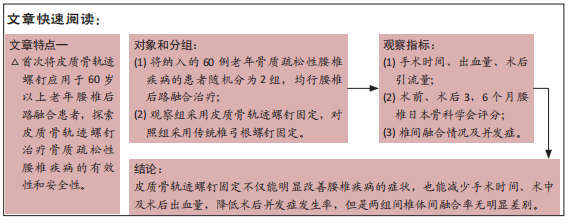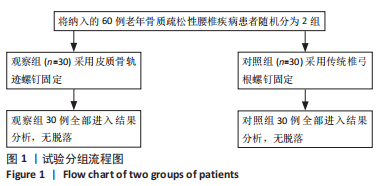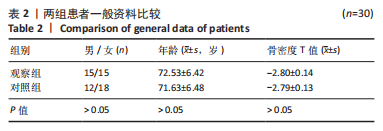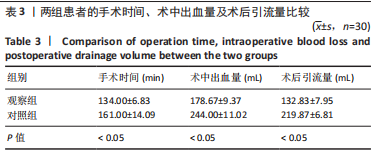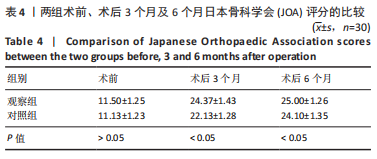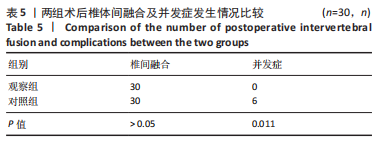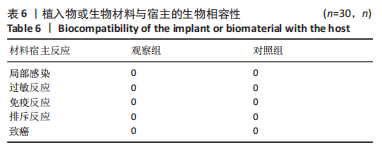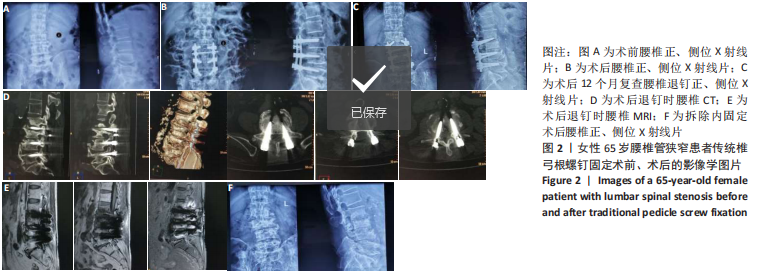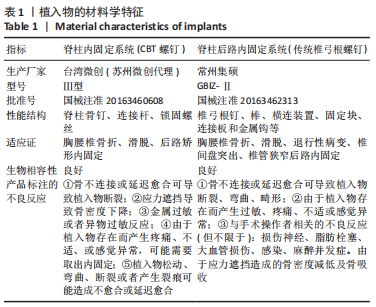[1] BRAYDA-BRUNO M, TIBILETTI M, ITO K, et al. Advances in the diagnosis of degenerated lumbar discs and their possible clinical application. Eur Spine J. 2014;23 Suppl 3:S315-S323.
[2] OMIDI-KASHANI F, HASANKHANI EG, ASHJAZADEH A. Lumbar spinal stenosis: who should be fused? An updated review. Asian Spine J. 2014;8(4):521-530.
[3] REXITI P, AIERKEN G, WANG S, et al. Anatomical research on strength of screw track fixation in novel cortical bone trajectory for osteoporosis lumbar spine. Am J Transl Res.2019;11(11):6850-6859.
[4] SANTONI BG, HYNES RA, MCGILVRAY KC, et al. Cortical bone trajectory for lumbar pedicle screws. Spine J. 2009;9(5):366-373.
[5] LEE GW, AHN MW. Comparative Study of Cortical Bone Trajectory-Pedicle Screw (Cortical Screw) Versus Conventional Pedicle Screw in Single-Level Posterior Lumbar Interbody Fusion: A 2-Year Post Hoc Analysis from Prospectively Randomized Data. World Neurosurg. 2018;109:e194-e202.
[6] 刘玉增,海涌,张希诺,等. 皮质骨轨迹螺钉固定与椎弓根螺钉固定在腰椎后路融合术中的疗效[J]. 中华医学杂志,2019,99(19):1473-1478.
[7] WEISER L, HUBER G, SELLENSCHLOH K, et al. Insufficient stability of pedicle screws in osteoporotic vertebrae: biomechanical correlation of bone mineral density and pedicle screw fixation strength. Eur Spine J. 2017;26(11):2891-2897.
[8] EL SA, MEIER S, SANDER A, et al. Reduced loosening rate and loss of correction following posterior stabilization with or without PMMA augmentation of pedicle screws in vertebral fractures in the elderly. Eur J Trauma Emerg Surg. 2013;39(5): 455-460.
[9] REXITI P, AIERKEN G, WANG S, et al. Anatomical research on strength of screw track fixation in novel cortical bone trajectory for osteoporosis lumbar spine. Am J Transl Res. 2019;11(11):6850-6859.
[10] SOSHI S, SHIBA R, KONDO H, et al. An experimental study on transpedicular screw fixation in relation to osteoporosis of the lumbar spine. Spine (Phila Pa 1976). 1991;16(11):1335-1341.
[11] GAO H, ZHANG R, JIA C, et al. Novel Placement of Cortical Bone Trajectory Screws in the Lumbar Spine: A Radiographic and Cadaveric Study. Clin Spine Surg. 2018;31(6):E329-E336.
[12] SKINNER R, MAYBEE J, TRANSFELDT E, et al. Experimental pullout testing and comparison of variables in transpedicular screw fixation. A biomechanical study. Spine (Phila Pa 1976). 1990;15(3):195-201.
[13] REXITI P, AIERKEN G, WANG S, et al. Anatomical research on strength of screw track fixation in novel cortical bone trajectory for osteoporosis lumbar spine. Am J Trans Res. 2019;11(11):6850-6859.
[14] WILKES RA, MACKINNON JG, THOMAS WG. Neurological deterioration after cement injection into a vertebral body. J Bone Joint Surg Br. 1994;76(1):155.
[15] LI HM, ZHANG RJ, GAO H, et al. Biomechanical Fixation Properties of the Cortical Bone Trajectory in the Osteoporotic Lumbar Spine. World Neurosurg. 2018;119:e717-e727
[16] MAI HT, MITCHELL SM, HASHMI SZ, et al. Differences in bone mineral density of fixation points between lumbar cortical and traditional pedicle screws. Spine J. 2016;16(7):835-841.
[17] MATSUKAWA K, YATO Y, KATO T, et al. In vivo analysis of insertional torque during pedicle screwing using cortical bone trajectory technique. Spine (Phila Pa 1976). 2014;39(4):E240-E245.
[18] MOBBS RJ. Differences in bone mineral density between cortical bone trajectory and traditional lumbar pedicle screws: commentary. Spine J. 2016;16(7):842.
[19] TAKENAKA S, MUKAI Y, TATEISHI K, et al. Clinical Outcomes After Posterior Lumbar Interbody Fusion: Comparison of Cortical Bone Trajectory and Conventional Pedicle Screw Insertion. Clin Spine Surg. 2017;30(10):E1411-E1418.
[20] SAKAURA H, MIWA T, YAMASHITA T, et al. Posterior lumbar interbody fusion with cortical bone trajectory screw fixation versus posterior lumbar interbody fusion using traditional pedicle screw fixation for degenerative lumbar spondylolisthesis: a comparative study. J Neurosurg Spine. 2016;25(5):591-595.
[21] WANG J, HE X, SUN T. Comparative clinical efficacy and safety of cortical bone trajectory screw fixation and traditional pedicle screw fixation in posterior lumbar fusion: a systematic review and meta-analysis. Eur Spine J. 2019;28(7):1678-1689.
[22] CHIN KR, PENCLE F, COOMBS AV, et al. Clinical Outcomes With Midline Cortical Bone Trajectory Pedicle Screws Versus Traditional Pedicle Screws in Moving Lumbar Fusions From Hospitals to Outpatient Surgery Centers. Clin Spine Surg. 2017;30(6):E791-E797.
[23] CHEN Y, DEB S, JABARKHEEL R, et al. Minimally Invasive Lumbar Pedicle Screw Fixation Using Cortical Bone Trajectory: Functional Outcomes. Cureus. 2018;10(10):e3462.
[24] 王海峰,曾忠友,金辉. 后路腰椎椎间融合术中使用皮质骨轨迹螺钉或椎弓根螺钉治疗腰椎退行性疾病[J]. 脊柱外科杂志,2020,18(1):53-57.
[25] 付荣华,耿晓鹏,付国勇,等. 椎弓根皮质骨通道与常规通道螺钉治疗骨质疏松性腰椎疾病[J]. 中国矫形外科杂志,2020,28(5):405-410
[26] ZHANG L, TIAN N, YANG J, et al. Risk of pedicle and spinous process violation during cortical bone trajectory screw placement in the lumbar spine. BMC Musculoskelet Disord. 2020;21(1):536.
[27] NAMBA RS, INACIO MC, PAXTON EW. Risk factors associated with deep surgical site infections after primary total knee arthroplasty: an analysis of 56,216 knees. J Bone Joint Surg Am. 2013;95(9):775-782.
[28] OKUDA S, NAGAMOTO Y, MATSUMOTO T, et al. Adjacent Segment Disease After Single Segment Posterior Lumbar Interbody Fusion for Degenerative Spondylolisthesis: Minimum 10 Years Follow-up. Spine (Phila Pa 1976). 2018;43(23):E1384-E1388.
[29] SAKAURA H, IKEGAMI D, FUJIMORI T, et al. Early cephalad adjacent segment degeneration after posterior lumbar interbody fusion: a comparative study between cortical bone trajectory screw fixation and traditional trajectory screw fixation. J Neurosurg Spine. 2019;32(2):155-159.
[30] KIM HJ, CHUN HJ, KANG KT, et al. The biomechanical effect of pedicle screws’ insertion angle and position on the superior adjacent segment in 1 segment lumbar fusion. Spine (Phila Pa 1976). 2012;37(19):1637-1644.
|
